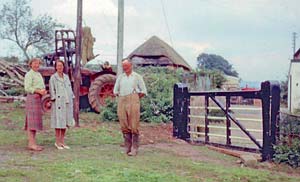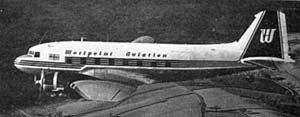
Exeter Stories
Exeter folk and friends in their own words - │ << Previous story │ Next story >> │
Doug Johns - the slow road to Exeter
In 1958, having recently left the Airforce, I spent my first summer as a 'civvy' on the Norfolk coast flying military aircraft. When winter drew on and flying was minimal, I spent a while instructing, but looked for something more permanent and testing! Hearing that the Exeter CAACU was looking for pilots - a part of Britain, where, in 1942 I had spent some months at Winkleigh on a farm watching the bombing of the City, and, also having had a number of excellent holidays in the South Hams, as well as a short stay at RAF Chivenor - it didn't need much persuading to set off for one of my favourite parts of Britain.
Having been wandering the World for some time and after leaving the RAF, living in pubs. or the occasional apartment, I had no fixed address or home, so being a wanderer what better than a caravan. With the prospect of being our Home for some time, it needed to be big enough to swing a small cat, and warm in winter, which meant the maximum size for towing (22 feet) and insulated. We settled on an excellent 'van' which had four separate compartments - the main being lounge and bedroom, where the double bed swung vertically up converting into a double settee seating four and table, built in wardrobe and cupboard space, the rear of the 'van' was a small bedroom (one two year old son at the time), and at the front a small kitchen to one side, and toilet/shower space opposite. The deal was soon settled and I went to pick it up with my car, newly fitted with tow bar.
My car had been bought in Cyprus when serving in the Airforce during the EOKA troubles, had been flown to Malta just prior the Suez war, and on completion of my 'tour' in '57, shipped (with us) by Italian steamer to Naples, where, my wife and I in ten days travelled thro' five Countries, arriving in Calais, where the car was flown back to Lydd. We had stayed in small Hotels, eaten well and had sufficient petrol for the journey, all on thirtynine pounds two shillings; leaving eighteen shillings for two fish and chip meals and petrol on landing on British shores - I had started out with only 40 pounds in my pocket - credit/debit cards there were none, and a cheque not too much use! She (the car), then spent two years getting me around Britain - in and out of the RAF.
So I arrived to pick up the caravan with a fairly well travelled and worn Simca Aronde 1290cc having all of nearly thirteen horses under the bonnet. After completing the paperwork, I was asked where I was taking her (the van), and when I said Devon, and I was towing her behind said Simca, there was a raising of eyebrows and a slight pause before asking that I keep them informed how the journey went and an obvious air of anticipation - this 'chaps' mad! The caravan was estimated with all 'bits' on board close to 2 1/2 tons, whereas, the car was closer to a ton! The 'nose weight' of the 'van' was on the heavy side, even with all the 'bits' to the rear, and on gently lowering her on to the towing 'ball' it reversed the rear springs of the car, which took on a decided 'begging' look. We set off the short distance to my Wife's parents, who lived just outside London, and parked on the street for the night. It needs to be remembered that there were far fewer cars in the '50's - it was a time when if you broke down, the next car along usually stopped to see if they could help you. Also, if you carried an AA or RAC badge on your badge 'bar', you were saluted on a fairly frequent basis by the Patrols on motorbike with sidecars. So having a fairly large caravan in a fairly small street didn't have the police saying ' You can't leave that there 'ere'!
Early the next morning we were waved away, after I had managed to find a street to reverse into, as we were facing the wrong way, and the adventure begun!
Dual carriage ways, motorways, there were none - the M1 starting it's northerly journey was not open until the end of '59.
The A30, in those days the Gt South West Road, and a single carriageway all the way, was the route, and, I had asked the AA to give me the gradients of all the hills along the way. Apart from one, and I can't remember exactly which one but somewhere around Sherboune/ Yeovil, all were considered OK. They said this one could be a problem as it was long and steep, and gave a routing around it. I hadn't given them details of my car or the caravan, so presumably they were considering a camping van and possibly a bigger car.
It became obvious fairly rapidly that on the flat I could not get out of third gear, as, as soon as I changed to top (only four gears), the car laboured and the slightest rise meant a change down anyway. So we proceeded, having almost an open road once away from London, and seldom more than two cars in sight at any one time in the London area. As we got further westward, the hills started to appear, and fortunately as the road is fairly straight and most upslopes had a downslope proceeding it, I managed to use the momentum of the preceding hill to get some threequarters of the way up the next slope before rapidly changing down, on the worst, to first gear. I say I used the momentum as we set off down hill - it would be better to say I made sure I kept ahead of the accelerating 'van', keeping the whole lot straight, as had I tried to brake, the way a 'van' brake works is that the towing arm being compressed against a spring, applies the 'van' brakes which not only loses valuable inertial energy, but also tries to 'jacknife' the much lighter load ahead. By this time we were most of the time the only humans in some beautiful countryside, and fortunately no other animal species - sheep, cows, etc., appeared on the road, and, on the downslopes I was actually in top gear!
After a number of stops for light refreshments, and taking in the view - as well as checking that the car still seemed to be holding together, we reached the dreaded hill which had no downslope preceding it and soared skywards. I'd decided not to take the AA alternate route, as it was longer and had hills, although less steep, and as there were so few cars on the A30 it was worth attempting the 'big' one, as, assuming we were still under way on the early part - and the rear of the car did not part company with the front, we should make it!
We set off in first gear and started climbing, and as I could see some distance both behind and ahead, a gentle weave was introduced to lessen the gradient - and it worked! We reached the top without stopping or seeing another car. From there it was all easy going, as we by now were seasoned caravanners and the car had proved itself in the ultimate challenge!
Approaching Clyst Honiton along the very narrow road, with high hedges making it difficult to see where the Airfield was, I decided to pull into quite a large layby just past a farm lane. Unhitching, the 'van', the car rebounded to it's normal height I was glad to see, and I now had to find somewhere to create at least a temporary home 'site', and where better than to ask at a farm.
Going back a few hundred yards, I turned up the lane to Treasbeare Farm and introduced myself to Phyllis and Leslie Tavender, the Farmer and his wife, who immediately said, well we have a field adjoining the Airfield, and we'd be happy for you to put it there.
Half an hour later we were parked in the middle of the field, where it was slightly flatter, as there's a fair slope down to the Airfield; also my car had had enough and protested at any attempt to reposition. We had arrived!
Leslie and Phyllis were a wonderfully hospitable couple, and, have remained firm friends. Leslie died some years ago and Phyllis may well have done so as we have failed to make contact over Christmas as usual.
1959 was a wonderful summer in all ways! Superb weather, excellent flying on the CAACU and at the Club, and I simply hopped over the gate on to the Airfield to walk across to the tower, picking mushrooms when they appeared, and going back later to cook them. It was a very quiet Aerodrome in those days, as the CAACU and the light aircraft were virtually all that were operating. We met old friends and made new ones, including Yvonne Pope, who was the deputy Chief Flying Instructor on the Club, and who had two young boys, and, with the excellent weather soon became playmates on Exmouth beach. Yvonne later became the first woman Jet Commercial Captain in Britain.
The car had to have a replacement clutch before going any further, and the leaves of the rear springs returned to normal shape, although, I swear the car was 6 inches longer; but it speaks highly of the Simca Aronde!
It could never happen today, and, you definitely need to be young and certainly naive on towing in general, to even try it. But worth the adventure! A slow journey to Exeter, at the average speed of a bike, but a memorable one!
Next part - my time in the CAACU
© 2011 Doug Johnsl
Doug Johns joined the CAACU at Exeter Airport in 1959. This is his journey to Exeter in the days when motoring was an adventure.
 The farmer at Treasbeare Leslie Travender and his wife Phyllis. Doug Johns wife is between them.
The farmer at Treasbeare Leslie Travender and his wife Phyllis. Doug Johns wife is between them. A Dakota of Westpoint Aviation– one of the aircraft flown by Doug Johns while at Exeter.
A Dakota of Westpoint Aviation– one of the aircraft flown by Doug Johns while at Exeter.
│ Top of Page │